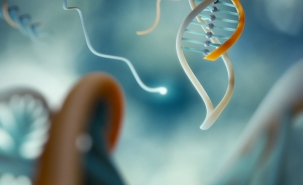Jan 30 2014
The road from simple nanomaterials and nanodevices to atomically precise manufacturing will involve integrating these simple components into ever more complex and capable systems. The early stages of such integration will also advance current and near-future nanotechnology across multiple application areas, as will be explored in the the Integration Conference, February 7-9, 2014, in Palo Alto, California.
A hat tip to Nanotechnology Now for news of this advance from researchers in Rome, Santa Barbara, and Montreal that integrates two basic interactions that have been exploited in DNA nanotechnology—Watson–Crick base pairing and triplex-forming Hoogsteen interactions—to form more sensitive and accurate nanoswitches. From a Université de Montréal press release “DNA clamp to grab cancer before it develops“
 Credit: Marco Tripodi
Credit: Marco Tripodi
- As part of an international research project, a team of researchers has developed a DNA clamp that can detect mutations at the DNA level with greater efficiency than methods currently in use. Their work could facilitate rapid screening of those diseases that have a genetic basis, such as cancer, and provide new tools for more advanced nanotechnology. The results of this research is published this month in the journal ACS Nano [abstract].
- Toward a new generation of screening tests
- An increasing number of genetic mutations have been identified as risk factors for the development of cancer and many other diseases. Several research groups have attempted to develop rapid and inexpensive screening methods for detecting these mutations. “The results of our study have considerable implications in the area of diagnostics and therapeutics,” says Professor Francesco Ricci, “because the DNA clamp can be adapted to provide a fluorescent signal in the presence of DNA sequences having mutations with high risk for certain types cancer. The advantage of our fluorescence clamp, compared to other detection methods, is that it allows distinguishing between mutant and non-mutant DNA with much greater efficiency. This information is critical because it tells patients which cancer(s) they are at risk for or have.”
- “Nature is a constant source of inspiration in the development of technologies,” says Professor Alexis Vallée-Bélisle. “For example, in addition to revolutionizing our understanding of how life works, the discovery of the DNA double helix by Watson, Crick and Franklin in 1953 also inspired the development of many diagnostic tests that use the strong affinity between two complementary DNA strands to detect mutations.”
- “However, it is also known that DNA can adopt many other architectures, including triple helices, which are obtained in DNA sequences rich in purine (A, G) and pyrimidine (T, C) bases,” says the researcher Andrea Idili, first author of the study. “Inspired by these natural triple helices, we developed a DNA-based clamp to form a triple helix whose specificity is ten times greater than a double helix allows.”
- “Beyond the obvious applications in the diagnosis of genetic diseases, I believe this work will pave the way for new applications related in the area of DNA-based nanostructures and nanomachines,” notes Professor Kevin Plaxco, University of California, Santa Barbara. “Such nanomachines could ultimately have a major impact on many aspects of healthcare in the future.”
- “The next step is to test the clamp on human samples, and if it is successful, it will begin the process of commercialization,” concludes Professor Vallée-Bélisle.
This research presents a clear case in which work aimed at better DNA sequence probes for diagnosis and therapy has yielded an improved device that the authors expect to also lead to, in the final words of their abstract, “better control over the building of nanostructures and nanomachines.”
—James Lewis, PhD